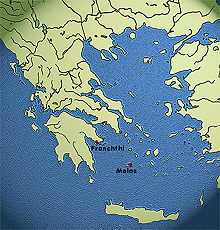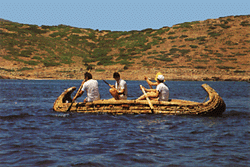
The Aegean has since prehistoric times been a sea of civilization that has united rather than separated the large or small strips of land areas whose shores it washed, from the geological period of the Pleistocene till today.

Recent archaeological data from the islands of the North Sporades, which around 18,000 BP formed the eastern border of Magnesia provide evidence of crossings in the Aegean on a small scale. Between these islands, there were narrow sea passages and shallow gulfs, accessible by some primitive sailing means.
Navigation of a larger scale in the Aegean, already by the 9th millenium BC has been testified by the tools made of Melian obsidian which were found in habitation levels of the Upper Palaeolithic, and more specifically in Franchthi Cave in Hermionid. It is worth noting that the the eastern coast of the Peloponnese lies at a distance of 80 nautical miles (approximately 150 kilometres) from Melos! Tools made of Melian obsidian found at archaelogical sites in the north (Nea Nikomedeia) but mainly on the central (Argissa, Euboea, Kitsos Cave) and south mainland of Greece (Franchthi), on Crete (Knossos) and on Cyprus, substantiate the existence of sea routes in the Aegean from the Early till the Final Neolithic (ca. 6800-3200 BC).

On examining the oldest pictorial records of ships from the Near East and Egypt, and from descriptions of navigation methods of the first sailing means as well as the prevailing conditions in the geographical area in question, it can be concluded that the first ships crossing the Aegean were probably made of papyrus and used oars. All the ships that sailed in the Aegean till the beginning of the 2nd millenium BC had oars before sails were introduced.
Taking as a model the double-prow "papyrella" of Corfu which was used in recent times to travel from Corfu to Italy without sails, the Hellenic Institute for the Preservation of the Nautical Tradition launched an experimental journey from Laurion to Melos in October 1988. For this purpose a double-prow reed vessel (raft or pirogue), the so-called "papyrella", was manufactured to accommodate a six-member crew of oarsmen. Its length was approximately 5 m., its width 1,5 m. and its height 60 cm. This experimental trip demonstrated that the seamen of the Aegean could travel from Lavrion to Melos in seven days.





